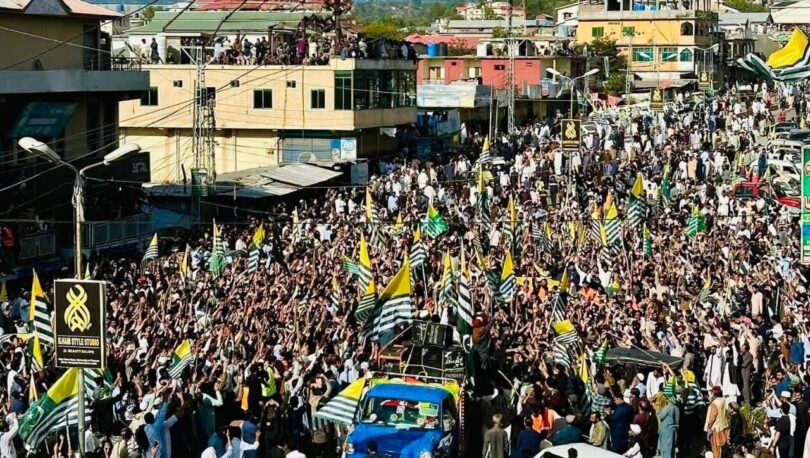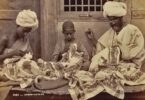By Jammu Kashmir National Students Federation (JKNSF)
The roads of Pakistani Administered Jammu Kashmir have been transformed into battlegrounds of resistance. What began as a peaceful mobilization around a 38-point charter of demands has turned into a popular uprising against the ruling elite. Local police, along with Islamabad Police, Frontier Constabulary, Punjab Constabulary, and Rangers, have been deployed in Kashmir to crush the demonstrations, and a total blackout and internet curfew have been imposed since 28 September. Reportedly, eleven protesters have so far been killed and dozens wounded in different parts of Pakistan-held Kashmir.
(For background on current events, see:” Victorious Movement in Jammu Kashmir: A Prelude to Revolutionary Tremors in the South Asian Sub-Continent“)
The Jammu Kashmir Joint Awami Action Committee (JAAC), an umbrella coalition of workers, masses, traders, students, and transporters, called for a shutter-down and wheel-jam strike on 29 September in support of the 38-point charter. The demands included the abolition of refugee seats in the assembly, tax relief, free healthcare and education, fair employment opportunities for local youth, and an end to the obscene privileges enjoyed by the political, bureaucratic, and judicial elite. The strike brought daily life across the Pakistan held Kashmir to a standstill, demonstrating the involvement of the masses. When the government dismissed the call as insignificant, the JAAC escalated matters by announcing a long march to Muzaffarabad, the capital of Pakistan held Kashmir, on 30 September.
The government’s response has been the familiar use of brute force, internet blackouts, and attempts to criminalize mass protest. On 1 October, clashes in Palak, Dadyal, Dhirkot, and Muzaffarabad left at least eleven dead and scores wounded. As this report is being written, news continues to emerge of more people being martyred. These killings follow days of systematic repression, including armed attacks on demonstrators by fundamentalist groups aligned with the establishment. Since 28 September, the complete shutdown of communication networks has cut people off from the outside world.
This uprising cannot be reduced to a dispute over subsidies. At its core, it is a revolt against the structural exploitation of its resources. Hydropower is generated in the region, but its benefits flow outward to the mainland Pakistan while politicians, bureaucrats, and judges of Pakistan held Kashmir enjoy obscene privileges. Tax burdens fall on small traders and working people, while corruption and patronage dominate governance. The entire government apparatus operates under Colonial Act 74 of the Pakistani Constitution, which cannot be amended without the approval of the Government of Pakistan — leaving the people of Pakistan held Kashmir with no voice.
Among the 38 demands is the call to abolish the 12 seats in the legislative assembly reserved for refugees who migrated from Jammu Kashmir to Pakistan between 1947–48. These reserved seats are a deliberate mechanism to maintain control, as they dilute local representation and ensure that the region’s political institutions remain subordinate.
The grievances raised by the movement expose the contradictions of a system designed to extract wealth while denying accountability. Popular anger is not directed at any single politician or state institution but at the entire apparatus of exploitation — the alliance of the ruling elite, which includes politicians, bureaucrats, judges, and military interests who profit from colonial rule. The violent repression of peaceful protests has once again revealed the nature of the state apparatus, which, as Engels said, is nothing but “a special coercive force.”
The 38-point program itself represents the political awakening of a people long denied agency. On one side stands the Pakistani-backed comprador ruling class, whose very existence depends on colonial domination and the preservation of the status quo; on the other side are the working people, small traders, farmers, and unemployed youth demanding an end to extractive rule, popular sovereignty, and control over the state’s resources.
The blackout imposed on Pakistan-held Kashmir is not simply a technical measure; it is an attempt to prevent news of state violence from reaching the global working class, to spread delusions, and to manufacture fake news. Corporate media has already portrayed the movement as a failed strike or even labeled it a foreign agenda. Most importantly, the blackout aims to curb any chance of class solidarity and sympathy. Hundreds of thousands of migrant workers and families abroad remain cut off from their relatives, their only information coming through scattered reports of killings and arrests.
With the JAAC’s decision to continue the long march towards Muzaffarabad, the confrontation will deepen. If Islamabad refuses to abolish refugee seats, end the privileges of the ruling elite, and fulfill the demands, further escalation is inevitable. The working people of Pakistan-held Kashmir have already shown they are willing to defy curfews, endure blackouts, and face bullets. Only a retreat into reformism by the leadership, or a resort to mass killings by the state, can prevent the masses from winning — but even that cannot hold back the tide for long. This movement will not retreat easily or peacefully, as people have already witnessed the uprisings in Nepal and Bangladesh, and such comparisons are now openly heard on the ground.
Overseas Kashmiris have already begun organizing demonstrations in front of Pakistani consulates and embassies around the world. For the international left, solidarity with this movement is an urgent necessity. Left-wing forces must amplify the voices of the oppressed masses of Pakistan-held Kashmir and press for an immediate end to the killings and the communication blockade in Jammu Kashmir and accept the demands of JAAC.
Equally, the working masses of Pakistan remain the most powerful source of solidarity. As one of the main leaders of JAAC, Sardar Amaan Khan, appealed to the workers and youth of Pakistan: “This is also your fight. Join our hands for victory!”






